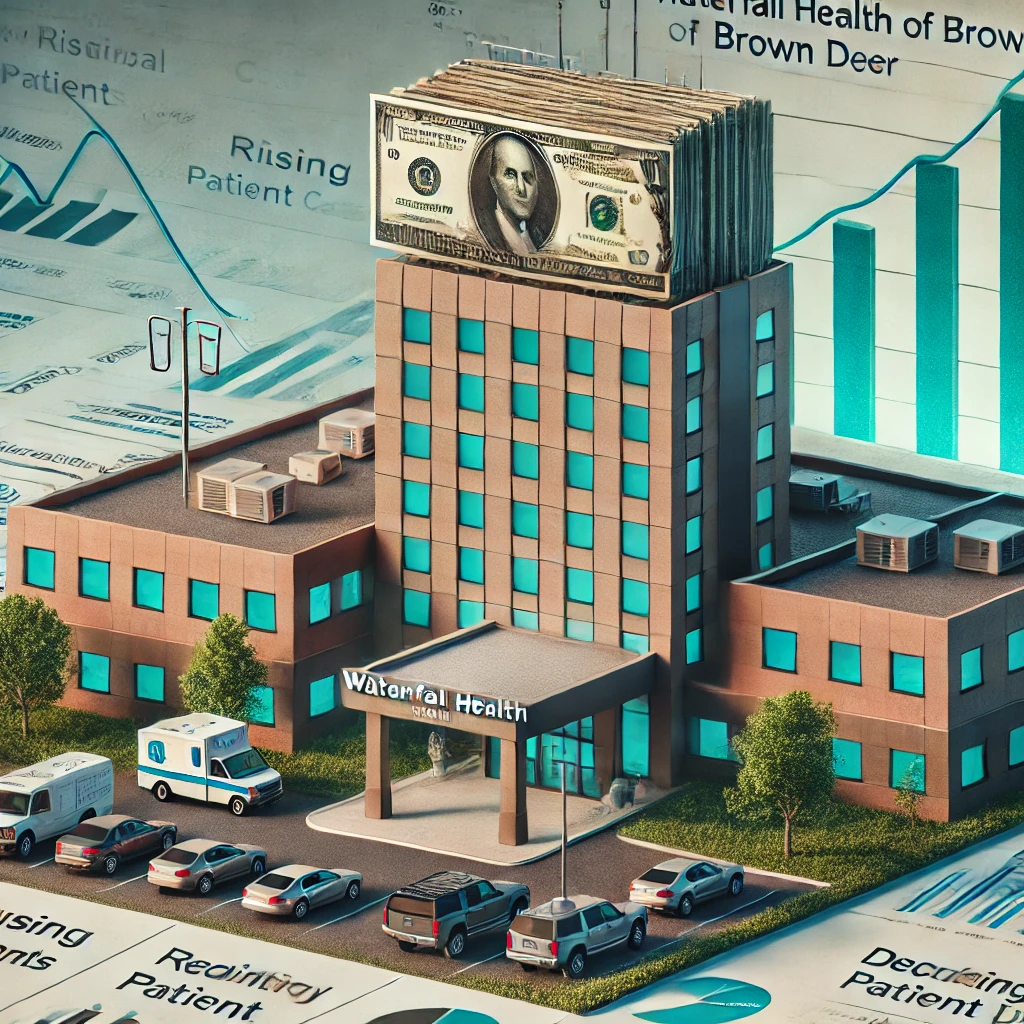Waterfall Health of Brown Deer LLC, once a notable healthcare facility in Brown Deer, Wisconsin, served the local community by providing a range of essential medical services. Known for its commitment to quality patient care, Waterfall Health had built a solid reputation in preventive and wellness-focused healthcare. However, recent financial struggles led to a surprising downturn, culminating in the bankruptcy of Waterfall Health of Brown Deer LLC. The bankruptcy proceedings, consequently, have brought to light various challenges within the healthcare sector, ranging from operational costs to shifting patient care models. This article, therefore, delves into the complex factors that may have contributed to Waterfall Health’s financial downfall, while also exploring broader implications for similar healthcare institutions. By examining these factors, this article seeks to provide insight into how such challenges can be anticipated and potentially mitigated in the future.
Waterfall Health of Brown Deer LLC Bankruptcy: Rising Operational Costs in Healthcare
One of the foremost contributors to Waterfall Health of Brown Deer LLC’s financial distress was the ever-increasing operational costs. Healthcare facilities, by their nature, face substantial expenses in maintaining high standards of patient care, with significant portions of the budget dedicated to medical equipment, pharmaceuticals, facility upkeep, and competitive staffing. Waterfall Health’s efforts to stay current with the latest medical technologies and attract qualified personnel required substantial financial resources. This, therefore, strained the facility’s ability to maintain profitability. As costs continued to rise across the healthcare industry, the economic impact on Waterfall Health grew even more profound, creating a compounding financial burden that became increasingly difficult to manage.
Waterfall Health of Brown Deer LLC Bankruptcy: Declining In-Patient Visits and Revenue Impact
Healthcare facilities like Waterfall Health of Brown Deer LLC have increasingly been impacted by a shift towards outpatient services and virtual care. This trend, further influenced by technological advancements and evolving patient preferences, has, as a result, led to a reduction in in-person consultations and treatments. For Waterfall Health, therefore, this shift translated into decreased patient volumes, as more individuals sought remote consultations or alternative care models. With fewer patients requiring traditional hospital stays, revenue streams dwindled, thereby placing additional stress on the facility’s financial health. Ultimately, these reduced in-patient volumes contributed to Waterfall Health of Brown Deer LLC’s inability to sustain its operations.
Waterfall Health of Brown Deer LLC Bankruptcy: Potential Financial Mismanagement and Oversight Issues
Effective financial planning and oversight are, therefore, critical for any healthcare organization aiming to maintain liquidity and meet its obligations. In the case of Waterfall Health, however, reports suggest that financial mismanagement may have contributed significantly to its bankruptcy. As such, this case underlines the importance of maintaining rigorous financial oversight and prudent planning in the healthcare sector. Whether through budgeting oversights, investment misjudgments, or inadequate strategic planning, any lapse in financial management could result in severe financial instability. For healthcare facilities, where operational margins are often thin, a lack of effective financial governance can, consequently, lead to insurmountable budget gaps. This, in turn, creates severe challenges in meeting financial obligations, covering debts, and investing in essential resources. Thus, the absence of sound financial oversight can impact the facility’s sustainability, placing it at considerable risk of financial distress.
Regulatory Compliance Challenges and Costs
Healthcare facilities must adhere to strict regulatory requirements, which often entail high compliance costs. From licensing and regular audits to facility upgrades and staffing mandates, these regulations are essential for ensuring patient safety and quality standards but can also be a financial strain. For Waterfall Health of Brown Deer LLC, staying compliant with both federal and state healthcare standards added substantial expenses. As regulations increased in complexity, the associated costs grew, contributing to financial strain on the organization. The rising costs of regulatory compliance created another layer of financial burden, ultimately impacting the facility’s ability to stay operational.
The Broader Implications of Waterfall Health of Brown Deer LLC’s Bankruptcy
The financial collapse of Waterfall Health of Brown Deer LLC underscores the challenges that healthcare facilities face, particularly in managing operational costs, adapting to shifts in patient care preferences, and meeting regulatory standards. The case serves as a stark reminder of the vulnerability of healthcare organizations, especially those that struggle to adapt to industry changes. For other facilities, the lessons drawn from Waterfall Health’s bankruptcy, therefore, may further emphasize the importance of prudent financial management, diversification of revenue streams, and, in particular, a proactive approach to regulatory compliance. Consequently, these insights could help other healthcare institutions anticipate challenges and sustain their financial health over time.
The Burden of Technological Advancement in Healthcare
- High Costs of New Equipment: Modern healthcare demands constant upgrades to medical equipment, which often comes at a high cost. Waterfall Health, in its commitment to quality care, may have found itself struggling with the financial burden of acquiring and maintaining the latest technology.
- Balancing Innovation with Financial Stability: Investing in cutting-edge tools is essential but can drain resources if not managed carefully. For Waterfall Health, balancing these investments without sufficient returns added financial pressure.
- Short Lifespans of Medical Technology: Rapid advancements mean that expensive technology can become outdated quickly, leading to constant replacements that strained Waterfall Health’s finances.
The Evolving Patient Care Model
- Shift Towards Outpatient and Preventive Care: With a healthcare shift toward outpatient services, Waterfall Health saw reduced inpatient volumes, impacting revenue streams traditionally based on longer, in-person stays.
- Rise in Remote Consultations: Telehealth has grown substantially, allowing patients to consult with specialists online. This reduced foot traffic, which affected facilities like Waterfall Health, heavily reliant on physical visits.
- Impact of Alternative Care Options: Patients now have more options, including home care and urgent care clinics, which reduced Waterfall Health’s patient numbers and revenue.
Staffing Challenges and Financial Impact
- High Demand for Qualified Staff: Skilled healthcare staff are in high demand, and the cost of hiring qualified personnel can be prohibitive. Waterfall Health may have struggled with competitive wages, further impacting their finances.
- Staff Retention Amid Financial Strain: Financial instability often leads to high staff turnover, which can lead to more costs related to hiring and training replacements, creating a vicious cycle of expenses.
- Burnout and Operational Challenges: With fewer resources, staff can become overworked, affecting both patient care and the facility’s reputation, which can indirectly impact patient volumes and income.
Managing Debt and Financial Obligations
- Accumulation of Debts: Like many healthcare facilities, Waterfall Health may have accumulated debt from loans and deferred payments, adding to its financial stress.
- High Interest Payments: Regular interest payments on outstanding debts can quickly add up, reducing cash flow and making it challenging for facilities to meet other financial obligations.
- Struggles with Timely Payments: Meeting financial obligations like vendor payments and staff salaries became increasingly difficult, pushing Waterfall Health further into financial distress.
Community Impact of Waterfall Health’s Bankruptcy
- Loss of Trusted Local Healthcare Facility: For the Brown Deer community, Waterfall Health represented reliable healthcare access. Its bankruptcy has left a gap, requiring patients to seek alternatives that may not be as convenient.
- Job Losses and Economic Strain: The closure led to job losses, affecting not only healthcare staff but also other support roles, impacting the local economy and families dependent on those incomes.
- Reduced Healthcare Accessibility: With the closure of Waterfall Health, residents may face longer travel times or waiting periods for healthcare, affecting overall community wellness and accessibility.
Lessons for Other Healthcare Providers
- Importance of Diversified Revenue Streams: Facilities must look beyond traditional inpatient services and consider alternative revenue channels, such as telemedicine or partnerships with other providers.
- Need for Robust Financial Planning: Effective financial oversight, including regular audits and strategic budgeting, is crucial to maintain operational stability, especially in a cost-heavy industry.
- Adaptation to Changing Care Models: With healthcare evolving, facilities must adapt to meet patients’ needs, potentially integrating remote care options and preventive services to retain their patient base.
Conclusion
Waterfall Health of Brown Deer LLC’s bankruptcy, therefore, represents a complex interplay of multiple factors: rising operational costs, declining in-patient visits, financial management challenges, and, furthermore, the burdensome costs of regulatory compliance. As healthcare organizations, consequently, continue to navigate an evolving landscape, the story of Waterfall Health, thus, serves as a cautionary example. It highlights the critical importance of robust financial oversight, adaptability in care models, and strategic planning. For communities that are dependent on such facilities, the hope, ultimately, remains that lessons learned from Waterfall Health’s financial difficulties will help other institutions avoid a similar fate. This, thereby, ensures ongoing access to quality healthcare for all.

